Jacques Francis Worksheets
Do you want to save dozens of hours in time? Get your evenings and weekends back? Be able to teach about Jacques Francis to your students?
Our worksheet bundle includes a fact file and printable worksheets and student activities. Perfect for both the classroom and homeschooling!
Resource Examples
Click any of the example images below to view a larger version.
Fact File
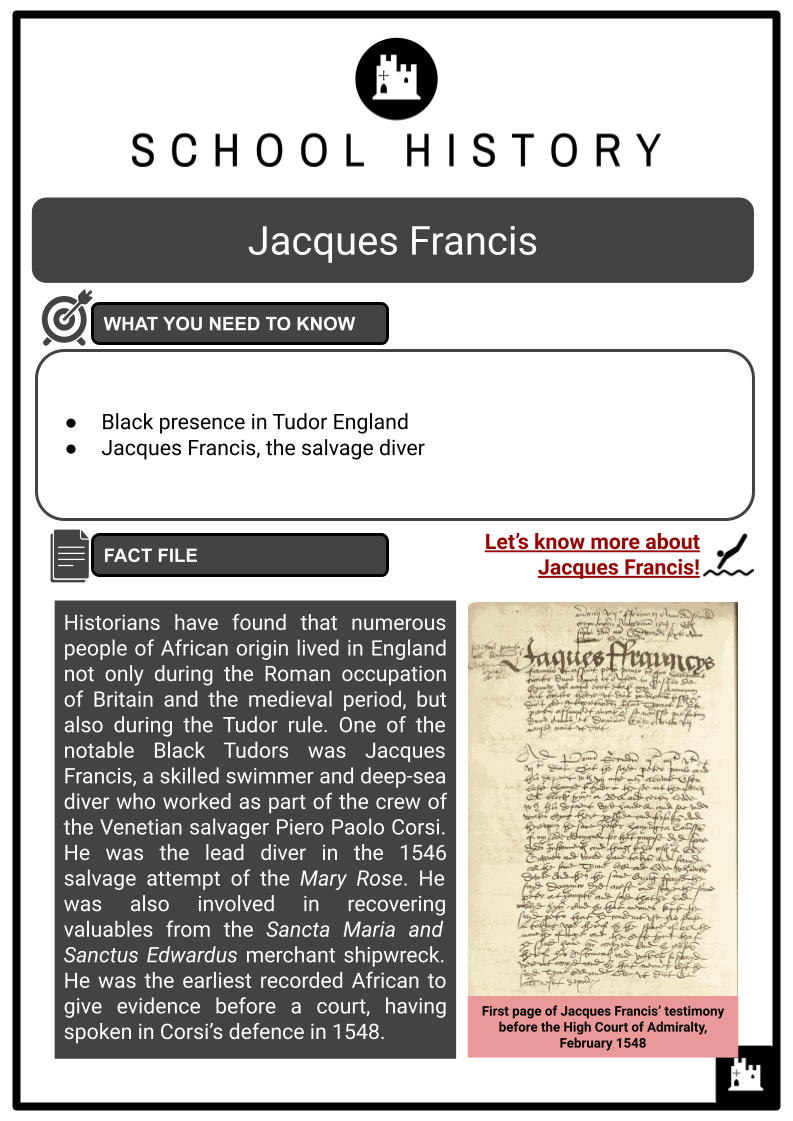
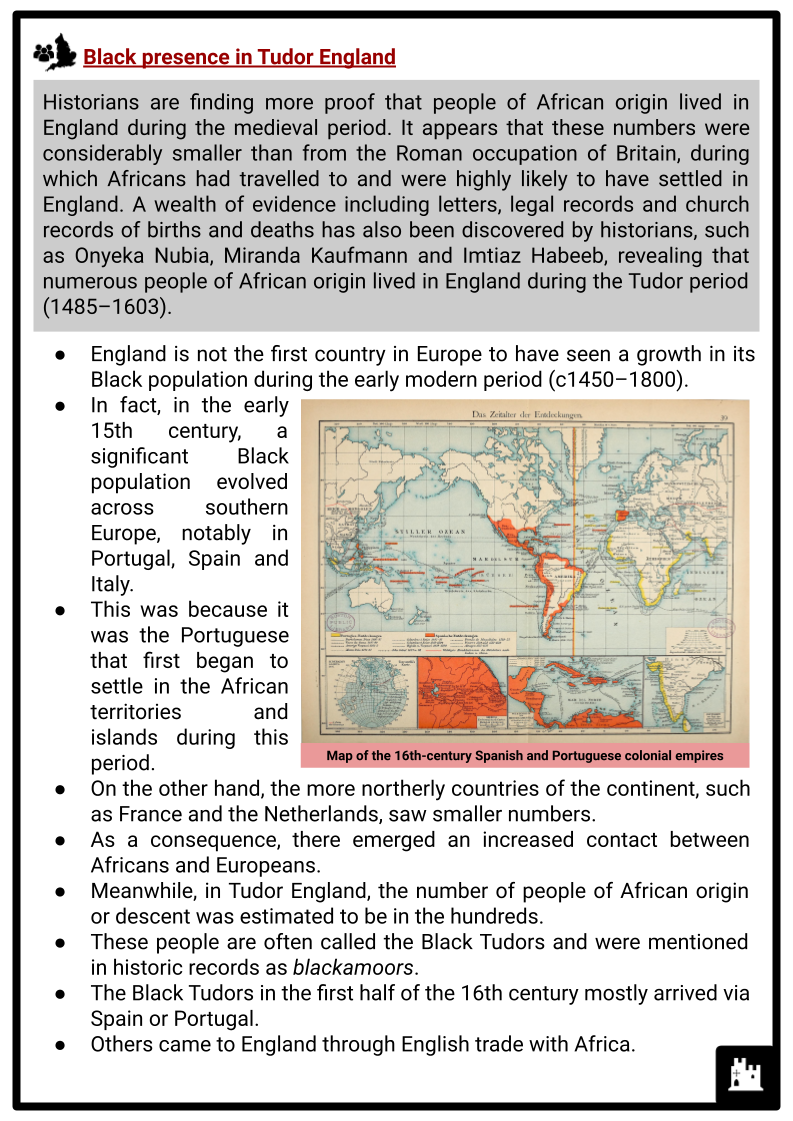
Student Activities
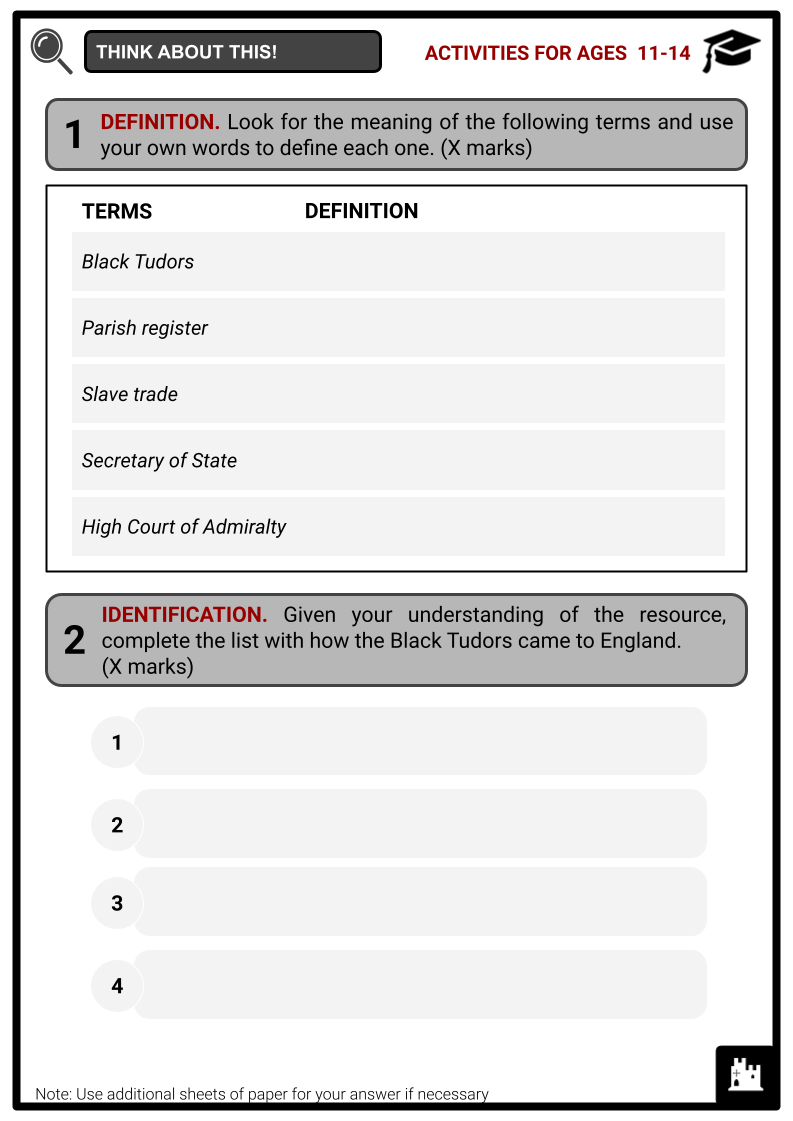
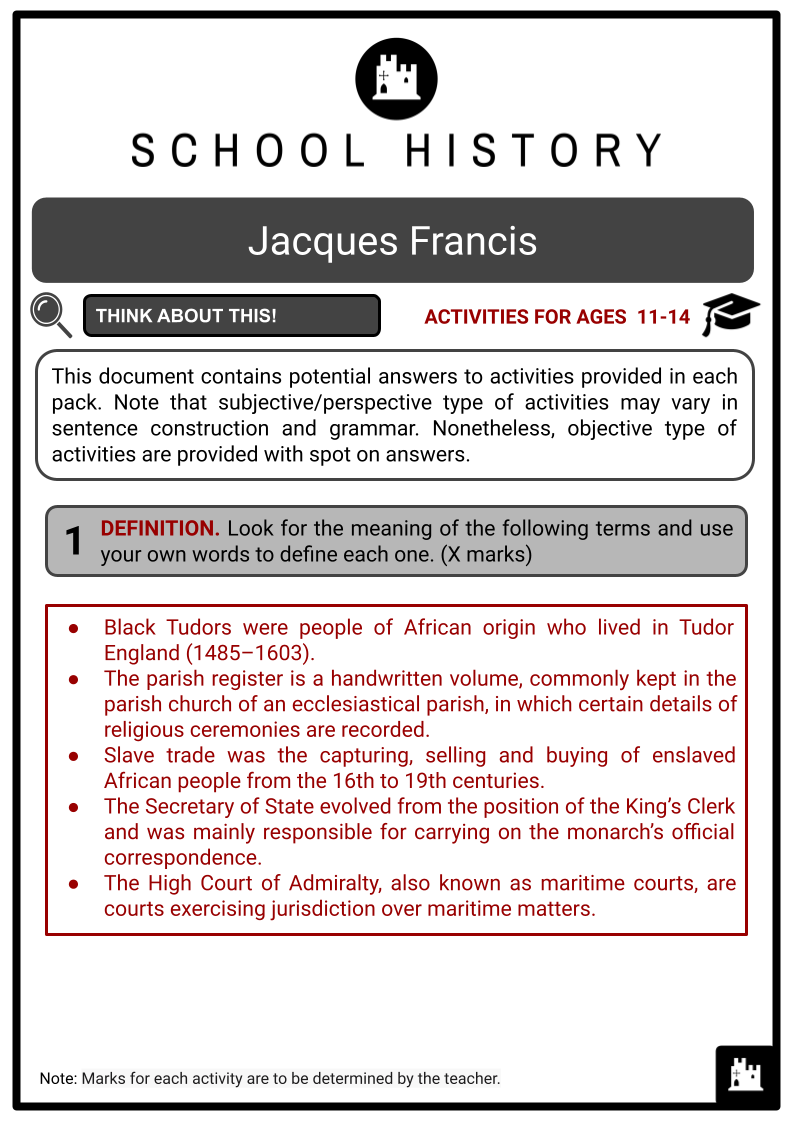
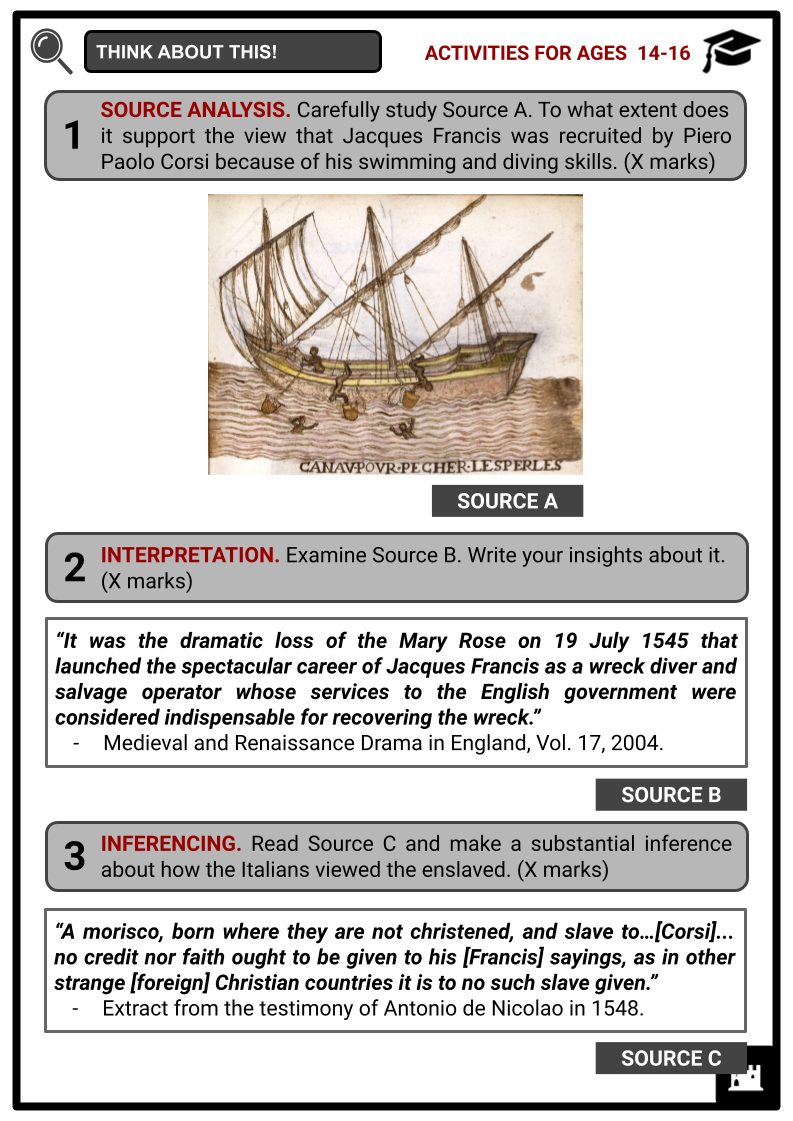
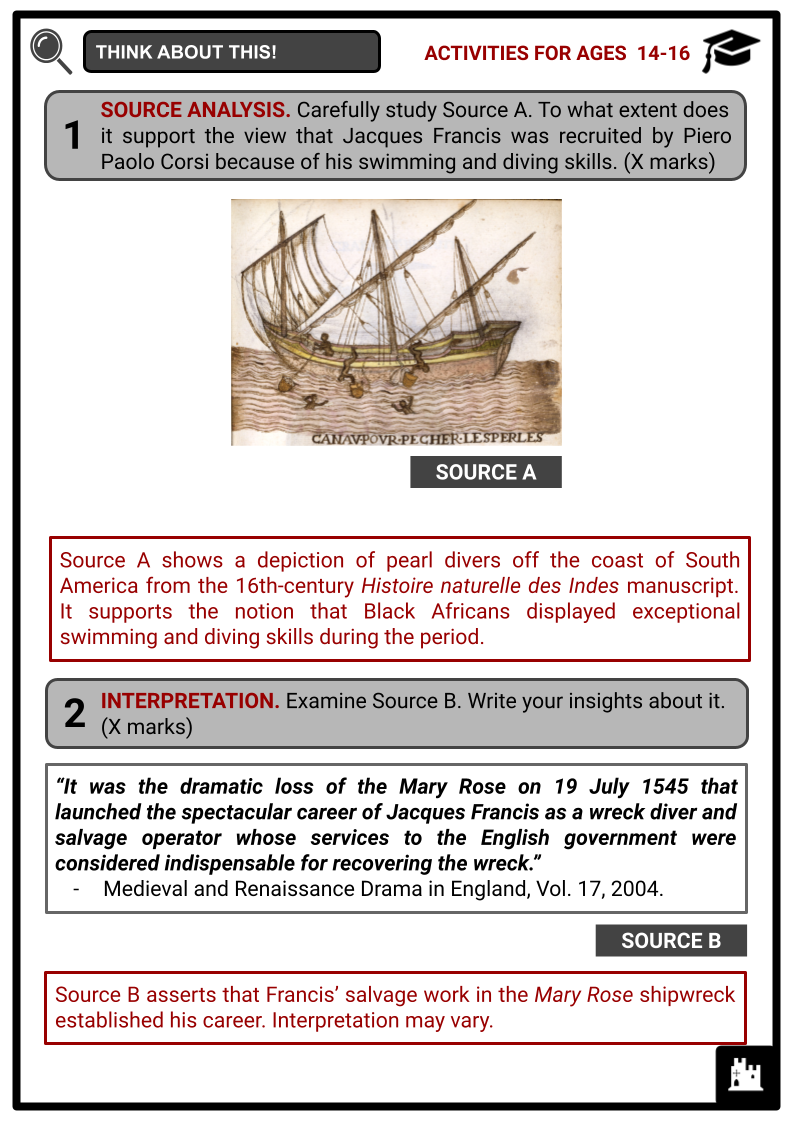
Summary
- Black presence in Tudor England
- Jacques Francis, the salvage diver
Key Facts And Information
Let’s know more about Jacques Francis!
Historians have found that numerous people of African origin lived in England not only during the Roman occupation of Britain and the Medieval Period, but also during the Tudor rule. One of the notable Black Tudors was Jacques Francis, a skilled swimmer and deep-sea diver who worked as part of the crew of the Venetian salvager Piero Paolo Corsi. He was the lead diver in the 1546 salvage attempt of the Mary Rose. He was also involved in recovering valuables from the Sancta Maria and Sanctus Edwardus merchant shipwreck. He was the earliest recorded African to give evidence before a court, having spoken in Corsi’s defence in 1548.
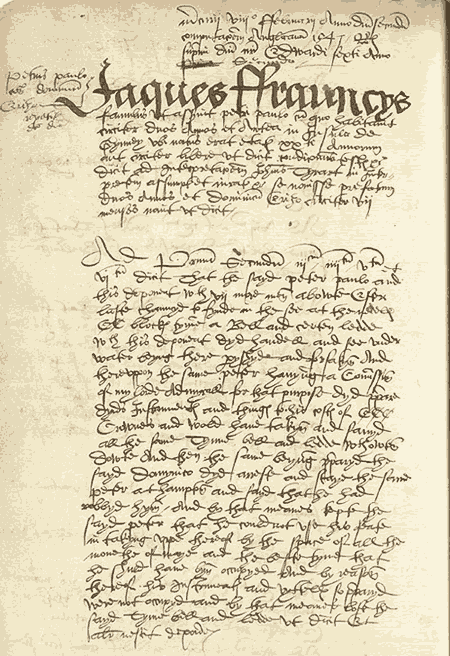
Black presence in Tudor England
- Historians are finding more proof that people of African origin lived in England during the medieval period. It appears that these numbers were considerably smaller than from the Roman occupation of Britain, during which Africans had travelled to and were highly likely to have settled in England. A wealth of evidence including letters, legal records and church records of births and deaths has also been discovered by historians, such as Onyeka Nubia, Miranda Kaufmann and Imtiaz Habeeb, revealing that numerous people of African origin lived in England during the Tudor period (1485–1603).
- England is not the first country in Europe to have seen a growth in its Black population during the early modern period (c1450–1800).
- In fact, in the early 15th century, a significant Black population evolved across southern Europe, notably in Portugal, Spain and Italy.
- This was because it was the Portuguese that first began to settle in the African territories and islands during this period.
- On the other hand, the more northerly countries of the continent, such as France and the Netherlands, saw smaller numbers.
- As a consequence, there emerged an increased contact between Africans and Europeans.
- Meanwhile, in Tudor England, the number of people of African origin or descent was estimated to be in the hundreds.
- These people are often called the Black Tudors and were mentioned in historic records as blackamoors.
- The Black Tudors in the first half of the 16th century mostly arrived via Spain or Portugal.
- Others came to England through English trade with Africa.
How did the Black Tudors come to England?
-
- Some came directly from Africa as traders or as ambassadors.
- Others arrived with the entourages of royals.
- Several travelled with merchants and aristocrats, especially when the English started to trade with Morocco and West Africa directly from the 1550s.
- Many came as the consequence of English privateering and raids on the Spanish empire.
- Parish registers from 1558 until the 17th century listed Black Tudors, which, aside from blackamoors, were described as ‘Neygers’, ‘Aethiopians’ and ‘Negroes’.
- These registers showed that the Africans were baptised, married to English people and buried in parish graveyards across the country, in both cities and the more rural areas.
- This suggests that Black Tudors resided in various locations in England.
- The Africans in Tudor England also took a variety of jobs, with a majority of them employed as servants. Others worked as weavers, sailors, labourers and musicians.
- Some of the Africans found to have lived in Tudor England are as follows:
- John Blanke, the royal trumpeter
- Jacques Francis, the salvage diver
- Diego, the circumnavigator
- Reasonable Blackman, the silk weaver
- Mary Fillis, servant
- Cattelena of Almondsbury
- Evidence of Black presence in Tudor England indicated that many of them were free members of society, contrary to the general view that all Africans were enslaved by the English. The reason for many Black Tudors’ legal status was that England did not participate in the slave trade until the first half of the 17th century. In fact, during the Tudor times, there was no legislation that explicitly forbade slavery in England, but neither was there a law that permitted it.
Jacques Francis, the salvage diver
- The experience of Black Tudors in England appears to be remarkable, owing to their independence. Unlike the majority of Africans across the rest of the Atlantic world, they were free, were paid wages, and were able to earn their own living and testify in court. They were integrated members of their local parishes and were baptised and married by the Church. They were employed at different levels of society. One of the popular Africans from Tudor England was Jacques Francis, a skilled swimmer and deep-sea diver.
Timeline of Francis’ life in England
- Born around 1527 or 1528, Francis’ exact place of origin remains unknown. Some historians believe that he was from Arguin Island, Mauritania.
- Francis had been working as part of the crew of the Venetian salvager Piero Paolo Corsi when the Admiralty began to look for companies to do the salvage work of the English warship Mary Rose in the 1540s.
The Mary Rose
- Launched in 1511, the Mary Rose was a flagship of Henry VIII’s navy and is thought to have been the king’s favourite ship. It served for more than three decades in numerous wars against France, Scotland and Brittany.
- After undergoing extensive reconstruction in 1536, it saw its final action on 19 July 1545 when it headed the attack on the galleys of a French invasion fleet. Unfortunately, it sank in the Solent, the strait north of the Isle of Wight. Only 35 escaped out of a crew of at least 400 seamen and soldiers.
- The Mary Rose was an important investment, as it was one of the first English warships to carry heavy cannons and weaponry valued at over £1,700 at the time. Hence, Henry VIII sought to recover as much of it as possible.
- A few days after the sinking of the ship, the Secretary of State William Paget ordered a salvage attempt, and Charles Brandon, the king’s brother-in-law, assumed responsibility for the practical details.
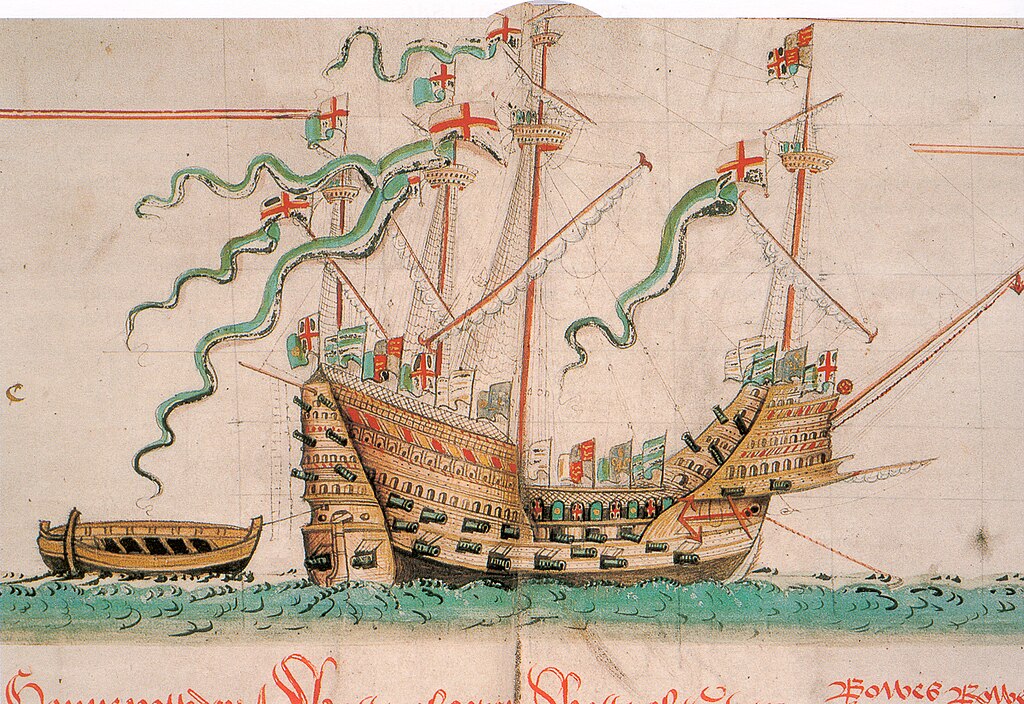
- Two earlier salvage operations were entrusted to Venetian mariners, owing to the lack of a capable English salvage company. However, these attempts to raise the Mary Rose failed. Further efforts to retrieve the ship were then abandoned. In 1546, Corsi and his team were commissioned to begin another salvage operation. Francis was one of the crew members according to the records in the High Court of Admiralty, and is believed to have been the lead diver. Payments to Corsi’s team were documented, and it was also revealed that under Francis’ lead, the team was able to successfully retrieve some of the weaponry from the wrecked warship.
Why were Africans recruited as divers?
-
- At this time, the majority of Europeans, including the English, could not swim, let alone dive. In fact, this was partly the reason for the high casualty rate of the Mary Rose.
- Meanwhile, Africans’ swimming and diving skills were remarkable as reported by many contemporary accounts from this period in Europe and European colonies.
- This meant that Africans, owing to their skills underwater, were likely in demand during this time.
- Two of Corsi’s crew members, George Blacke and John Iko, may also have been African.
- In 1547, Corsi’s team, which included Francis, had been employed to salvage valuables from the Sancta Maria and Sanctus Edwardus merchant ship that had sank off the coast of Southampton.
The Sancta Maria and Sanctus Edwardus
-
- In 1546, the Sancta Maria and Sanctus Edwardus caught fire and sank only two miles from the shore.
- It belonged to the Venetian Francesco Bernardi and carried goods of various other Italian merchants. The goods included wools, cloth, tin, leather and lead.
- Salvaging continued until the Italian merchants charged Corsi of taking the merchant ship’s bell, lead, and several blocks of tin from Dominic Erizzo and Bartolome Fortini, two prominent Florentine merchants based in London. Erizzo arrested and sued Corsi in the High Court of Admiralty. Francis was prompted to give evidence in support of Corsi.
- In February 1548, Francis, aged 20, appeared well-dressed before the court. He was given an interpreter when he testified ‘of his own free will’ since he could not speak English very well.
- Francis explained that he saw and handled the allegedly stolen items and claimed that they would have been quickly restored to Erizzo had Corsi not been arrested.
- With the intention to tarnish his reputation, three of the Italian witnesses in the case claimed that Francis was ‘a morisco, born where they are not christened, and slave to…[Corsi]’. Enslaved people were not allowed to testify in court during this period. Francis then asserted that he was a ‘famulus’ to Corsi, meaning an attendant or assistant, rather than a ‘servus’, meaning slave. He then accused Erizzo of interrupting their salvage operation by arresting Corsi during the best time for diving. The Italians’ claims were ignored, and Francis’ testimony was acknowledged by the court. This revealed that Francis was regarded as an independent person in the eyes of the law.
- After this event in 1548, Francis disappeared from any official record and his date of death remains unknown.
Frequently Asked Questions
- Who was Jacques Francis?
Jacques Francis was an African salvage diver who led the expedition to salvage Henry VIII's guns from the Mary Rose.
- What is the Mary Rose?
The Mary Rose was a Tudor-era warship commissioned by King Henry VIII of England. It was one of the first purpose-built warships in the English Navy and played a role in several naval engagements during the early 16th century. The ship was named after Mary Tudor, the younger sister of Henry VIII.
- How were Black Tudors treated?
The treatment of Black Tudors in 16th-century England varied based on individual circumstances. Some held prestigious positions in the royal court, enjoying relative privilege. Others worked in common roles and faced challenges.
